Régulièrement, cette rubrique animée par Virginia Allum, auteur et consultante EMP (English for Medical Purposes), vous permettra, exercices à l'appui, de parfaire votre anglais médical au travers de situations de soins concrètes. Bon travail à tous ! Corrections en fin d'article...
N'hésitez pas à vous servir du dictionnaire en ligne Wordreference. Vous trouverez à la fin de cet article les corrections des exercices qui vous sont proposés téléchargeables au format pdf.
Activity 1 : What do you know about epilepsy?
Vocabulary : Epilepsy
Cours d'anglais sur l'épilepsie
- absence
- aura
- to convulse / convulsion
- fit / have a fit
- jerky movement
- seizure /have a seizure
- lose consciousness
True or false ?
- Epilepsy is a psychiatric condition.
- Seizures which last less than ten minutes can cause brain damage.
- People with epilepsy may get a warning before an epileptic fit.
- Epilepsy is a genetic disorder.
- All fits result in jerky movements.
- Some fits are like the person being ‘away’ for a few minutes.
- You not give a person food or drink if they are having a fit.
- Put something in the mouth to stop the person biting his tongue during a fit.
Activity 2 : Epilepsy
Epilepsy is caused by abnormal electrical activity of the brain. It leads to a change in brain function which causes seizures or epileptic fits. There are several types of seizures
- Petit mal which means ‘small bad thing’ – these seizures are also called ‘absences’ because the person seems to ‘go away for a while’.
- Grand mal which means ‘big bad thing’ – during a grand mal seizure people move their arms and legs around with jerky or uncontrollable movements.
Epileptic fits are not usually harmful unless they happen during activities like swimming or driving a car. This is because some people with epilepsy do not get any warning or a very short warning before they have a fit. It is, however, important to maintain a healthy lifestyle.
People with epilepsy who do get a warning may experience an unusual smell or sight. This is called an aura. Some people also identify triggers which they are able to avoid if possible. If a fit cannot be avoided, it starts with the person falling down. Their arms and legs convulse without any control. They usually lose consciousness or ‘pass out’. Most people recover within five minutes without ill effect. However, medical attention should be sought for a person whose seizure lasts more than five minutes.
Read the text above and match the terms in the text with their correct meanings
| 1. aura | a) sudden epileptic fit |
| 2. trigger | b) sudden movements which a person cannot control |
| 3. seizure | c) appear not be aware of your surroundings for a moment |
| 4. absence | d) fits, involuntary movements |
| 5. jerky | e) something which starts something else happening |
| 6. sight | f) to faint |
| 7. convulsion | g) a feeling that a person is about to have a fit. |
| 8. lose consciousness | h) ability to see |
Activity 3 : Answer the following questions.
- Epilepsy is caused by a change in _______________________.
(a) brain function
(b) muscle function
(c) mind function
- An absence is when a person appears to stop ________________.
(a) hearing
(b) concentrating
(c) speaking
- People may move around ________________ during a grand mal fit.
(a) uncontrollably
(b) a lot
(c) easily
- Some people get a ______________ that they are about to have a fit.
(a) treatment
(b) trigger
(c) warning
- During a fit, people may _____________ or lose consciousness.
(a) pass out
(b) pass in
(c) pass through
Activity 4
Watch the video above and put the notes in the order you hear them. The transcript is at the end after the answers
- a. roll on side until comes round
- b. something soft under his head
- c. tablets to prevent fits
- d. grandson has epilepsy
- e. no food or drink until recovers
- f. don’t put anything in his mouth
- g. check nothing can hurt him
- h. fit more than 5 mins, call ambulance
- i. wear an identity bracelet
- j. had epilepsy for 4 years
Activity 5 : Match the beginnings of the sentences with the correct endings
| 1. How long has Mark had epilepsy? | a) First, check there is nothing around which could hurt him. |
| 2. Is he taking any medication at the moment? | b) When the fit is over, roll your grandson onto his side until he comes round. |
| 3. When was the last time he had a fit? | c) No, don’t ever try to put anything in his mouth. |
| 4. What should I do if he has a fit when we’re out? | d) He takes tablets every day to prevent the fits. |
| 5. Should I put something in his mouth? | e) He’s had it for four years now. |
| 6. Is there anything else I should do? | f) The last time he had a fit was six months ago. |
Activity 6 : Look at the pictures and complete the following information
soft fluids assess bracelet safe lasts cushion recovery time identity over never
-
A is for ___________
Make sure the area is ___________
-
C is for __________
Put something ________ under his head
-
T is for _____________
How long it _____________
-
I is for _____________
He should wear an identity _____________
-
O is for roll _____________ until _____________
-
N is for _____________ give any _____________
Activity 7 : Reading an academic article
Read the following excerpt from an article found at onlinelibrary.wiley.com
Clinical Research Physical Exercise in Outpatients with Epilepsy - Nakken, K. O. (1999), Clinical Research Physical Exercise in Outpatients with Epilepsy. Epilepsia, 40: 643–651. doi: 10.1111/j.1528-1157.1999.tb05568.x
Abstract
Summary: Purpose: To compare the exercise habits in a sample of adult outpatients with epilepsy with those of a general population of the same age and sex and furthermore to study physical exercise as a seizure precipitant and the risk of sustaining seizure-related injuries while exercising.
Methods: Two hundred four adult outpatients with active epilepsy responded to two questionnaires. The first one, addressing exercise habits, was a selected part of a broad self-assessing screening used every second year by a marketing and media research institute to reveal changes in the average Norwegian's lifestyle. The exercise habits of the epilepsy population were compared with those of the average population. The other questionnaire, addressing seizures and injuries related to physical exercise, consisted of eight sections and was developed at the National Center for Epilepsy in Norway.
Conclusions: The surveyed sample of epilepsy outpatients was more active than expected, and their exercise pattern closely resembled that of the average Norwegian population. In the majority of the patients, physical exercise had no adverse effects, and a considerable proportion (36%) claimed that regular exercise contributed to better seizure control. However, in -10% of the patients, exercise appeared to be a seizure precipitant, and this applied particularly to those with symptomatic partial epilepsy. The risk of sustaining serious seizure-related injuries exercising seemed modest.
Answer the following questions.
- The research was undertaken to assess _____________________________.
(a) whether exercise triggers epileptic fits.
(b) whether exercise causes epileptic fits.
(c) whether exercise cures epileptic fits.
- The other purpose of the study was to assess____________________.
(a) the effect of exercise on epileptics.
(b) the risk of injury to epileptics during exercise.
(c) the benefit of exercise to epileptics.
- Two questionnaires were given to __________ people with epilepsy in Norway.
(a) 200
(b) 2000
(c) 204
- The first questionnaire compared _________________ of people with epilepsy and those who do not have epilepsy.
(a) exercise choices
(b) exercise frequency
(c) exercise habits
- The second questionnaire assessed ______________________.
(a) the relationship between injury during exercise and epilepsy
(b) the result of exercise during an epileptic fit.
(c) the cause of injury during exercise
- The conclusion of the questionnaire was that exercise ___________.
(a) did not make epilepsy worse
(b) made fits worse
(c) triggered epileptic fits
- There was a __________ of injury if a person had a fit when exercising.
(a) moderate risk
(b) very small risk
(c) strong risk
Activity 8 : The First Aid for epileptic fits
Woman: I need to ask a few questions about my grandson, Mark. He’s got epilepsy.
Nurse: I see. How long has Mark had epilepsy?
Woman: He’s had it for four years now.
Nurse: Is he taking any medication at the moment?
Woman: He takes tablets every day to prevent the fits.
Nurse: When was the last time he had a fit?
Woman: The last time he had a fit was six months ago. His grandfather and I are looking after him while his parents are on holidays. We don’t know what to do if he has a big fit.
Nurse: I understand your concerns. I can explain what to do if he has a big fit.
Woman: What should I do if he has a fit when we’re out?
Nurse: First, check there is nothing around which could hurt him.
Woman: I see. Should I put something in his mouth?
Nurse: No, don’t ever try to put anything in his mouth. Don’t try to move him during the fit. If you can, put something soft under his head to protect it from injury. Like a cushion or pillow.
Woman: OK. I won’t move him.
Nurse: Take a note of how long the fit lasts. If the fit lasts more than five minutes you should call an ambulance.
Woman: All right. I see.
Nurse: Your grandson should also wear an identity bracelet to say he has epilepsy.
Woman: Yes, he wears one all the time. Is there anything else I should do?
Nurse: When the fit is over, roll your grandson onto his side until he comes round.
Woman: Just roll him on his side until he comes out of the fit?
Nurse: That’s all you have to do. It’s also extremely important not to give him anything to eat or drink until he has completely recovered.
Woman: Thank you. I think I understand now. I just hope everything is OK.
Nurse: I’m sure you’ll manage well. I’ll give you the phone number of the Epilepsy Helpline. You may find them useful. They also have a website.
Woman: Yes, that’s a good idea. Thank you for explaining it to me. I feel a bit better about having our grandson over now.
Téléchargez les corrections au format PDF
Virginia ALLUM Author and Consultant in English for Medical Purposes United Kingdom


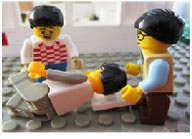


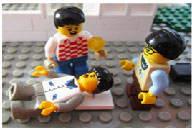
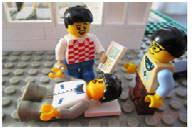
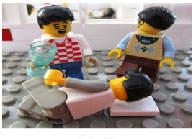

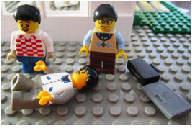
REFONTE DE LA FORMATION
L'idée d'un tronc commun en master hérisse les infirmiers spécialisés
ÉTUDES
D’infirmier à médecin : pourquoi et comment ils ont franchi le pas
VIE ÉTUDIANTE
FNESI'GAME : l'appli qui aide les étudiants infirmiers à réviser
PRÉVENTION
Des ateliers pour préserver la santé des étudiants en santé